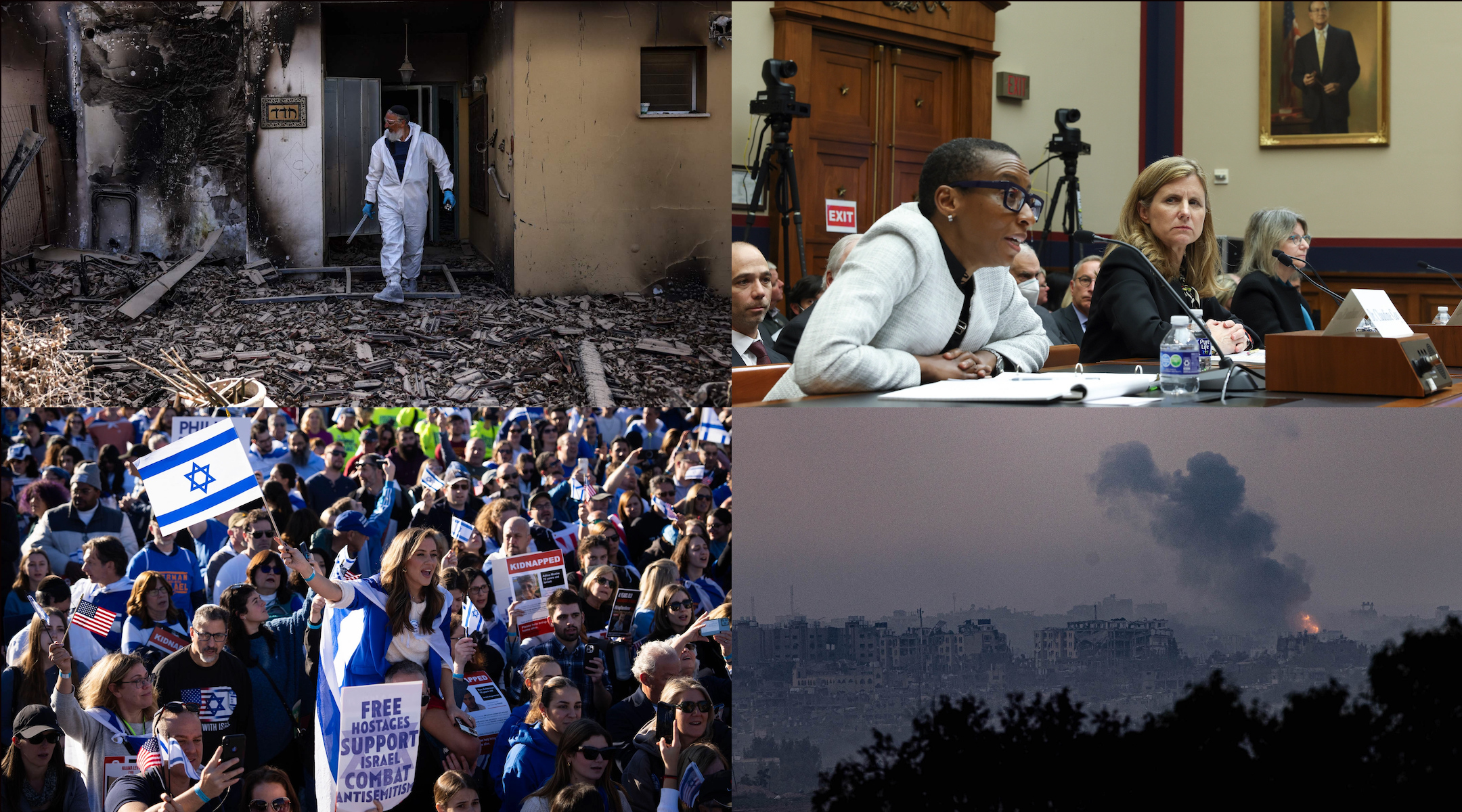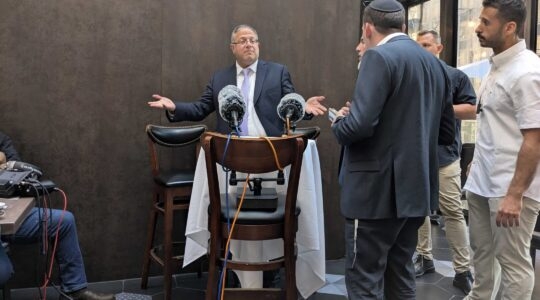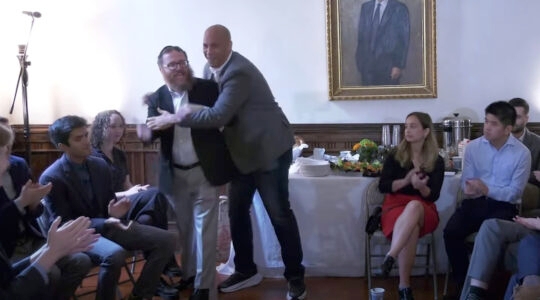(JTA) — For Jews who were not directly ensnared in the violence and terror of Oct. 7, the days that followed were characterized by rapidly changing numbers. The number of people known to be dead shot up, as did the number of rockets fired from Gaza and the number of mobilized Israeli troops. The number of kibbutzes that remained unsecured ticked downward. Reports of antisemitic incidents worldwide began to accumulate.
One hundred days later, some numbers have come into focus as meaningful for the long haul. Here are 10 that help explain what happened on Oct. 7 and in its aftermath.
1,391
Israelis killed since Oct. 7, as of Jan. 10. Hamas’ Oct. 7 invasion of Israel was a seismic moment in Israeli and Jewish history: Hamas terrorists killed approximately 1,200 people that day, mostly civilians, took hostages and wounded thousands — making it the bloodiest day in Israeli history and the deadliest day for Jews since the Holocaust. The attackers also committed numerous atrocities and destroyed several communities.
The attack shattered a ceasefire between Israel and Hamas, and launched the war. Israel invaded Gaza, aiming to depose Hamas. So far, more than 185 Israeli soldiers have been killed in the invasion.
136
Hostages still held in Gaza, as of Jan 7. On Oct. 7, Hamas took more than 240 people hostage, hailing from countries worldwide and ranging in age from an infant to an octogenarian. The campaign for their freedom — led by the hostages’ family members — has become a global activist movement. It spans a large-scale flier campaign, rallies and art installations in cities across the world and political advocacy.
Hamas freed more than 100 hostages during a seven-day truce in November. A number have been killed, including at least three unintentionally by the Israeli military. Relatives of the remaining hostages are pushing the Israeli government to negotiate for their release. The current total includes the bodies of hostages who were killed and two Israeli hostages believed to have been held alive in Gaza for years before Oct. 7.
23,357
Palestinians killed since Oct. 7, as of Jan. 10. Israel’s counteroffensive in Gaza, launched in the days after Oct. 7, has devastated the coastal enclave. The casualty figure, provided by the Hamas-run Gaza Health Ministry, covers both combatants and civilians, including thousands of children. Tens of thousands more have been injured.
The casualty figure — far higher than that of any previous Israel-Hamas conflict — has driven global calls by international bodies and left-wing activists for a ceasefire. Israel has rebuffed those calls and maintains that it makes extensive efforts to safeguard civilian life. It blames Hamas for putting noncombatants in harm’s way.
200,000 + 1.9 million
Israelis and Palestinians, respectively, displaced by the fighting. In addition to the war’s death toll, it has also driven masses of people from their homes. Hamas’ invasion of Israel ravaged the Gaza border region, sending thousands of residents to hotels where they have been living since Oct. 7. Tens of thousands more evacuated the area as it became a war zone, and further tens of thousands evacuated their homes on Israel’s northern border as clashes with the Lebanese terror group Hezbollah have ramped up.
Ahead of its invasion Israel ordered the population of the northern half of the Gaza to evacuate to the southern half, and its counteroffensive in the Gaza City area has destroyed a large number of homes. As Israel’s focus has moved south, residents there have also been told to evacuate, with Israel creating routes for safe passage. The vast majority of residents are now displaced.
768,533,361
Dollars raised by the Jewish Federations of North America, as of Jan. 3. Most American Jews have expressed sympathy with Israel in the wake of Oct. 7, and many have conveyed that feeling via their pocketbooks. The outpouring of donor dollars parallels spikes in Jewish giving to Israel during the country’s 1967 and 1973 wars.
JFNA, via its network of local Jewish federations, has raised perhaps the biggest single number, and allocated roughly a third of that money to a range of Israeli nonprofits. An array of synagogues and other organizations have also reported substantial hauls. It’s likely that American Jews have directed more than $1 billion dollars to Israel since Oct. 7.
72
Percentage of American Jews who said antisemitism has increased in their local communities, in a November survey. Alongside the Israel-Hamas war, many American Jews are increasingly concerned about reports of spiking antisemitism since Oct. 7. A recent survey by the Anti-Defamation League tallied 60 antisemitic assaults in that period and hundreds of incidents of vandalism. Anti-Jewish hate crimes have also spiked in New York City.
In the most severe incident, a Jewish man, Paul Kessler, died after being struck on the head at dueling pro-Israel and pro-Palestinian rallies. Jewish students have contended with death threats, while kosher and Jewish restaurants nationwide have been defaced or ransacked.
2
Ivy League presidents who resigned after a congressional hearing on campus antisemitism. The now (in)famous hearing, in early December, in which the presidents of three elite universities all declined to say outright that calling for the genocide of Jews would break school rules, led to two of the leaders stepping down. Penn’s Liz Magill resigned after pressure from students, faculty, donors and officials. Harvard’s Claudine Gay followed suit weeks later, bedeviled by a string of plagiarism accusations. MIT’s Sally Kornbluth appears to be hanging on.
In parallel, as concern about campus antisemitism has risen, the Department of Education has opened 45 civil rights investigations since Oct. 7, many concerning antisemitism at universities. “We take these threats and these beliefs of students of being unsafe on campus very seriously, and we’re going to thoroughly investigate them,” Education Secretary Miguel Cardona told JTA.
19
Percentage of Israelis who want Prime Minister Benjamin Netanyahu to continue in office after the war, as of Dec. 8. Netanyahu, unlike other leaders of Israel’s defense establishment, has not explicitly taken responsibility for Israel’s missteps ahead of Oct. 7. But Israelis are signaling that they will hold him responsible at the ballot box.
His government, which took office only about a year ago, is deeply unpopular. Election surveys show Netanyahu’s Likud party plummeting while centrist parties gain steam. Netanyahu, who is also on trial for corruption, has so far rejected calls to step down.
5
Trips Secretary of State Antony Blinken has taken to Israel since Oct. 7. After Hamas’ invasion, the Biden administration said it was standing shoulder-to-shoulder with Israel. President Joe Biden gave an Oval Office address calling for funding for Israel’s war effort, he visited Israel and has met with families of hostages. The United States has continued to defend the war in international bodies.
But recently, daylight between Biden and Netanyahu has begun to appear. Biden wants the Palestinian Authority to be in charge in Gaza on the day after the war, which Netanyahu opposes. Biden has also called on Netanyahu to disavow his far-right partners’ calls for transfer of civilians from Gaza — something the prime minister did this week.
300,000
West Bank Palestinians whose work permits into Israel have been revoked. Alongside the conflicts in Gaza and Israel’s northern border, violence has spiked in the West Bank. Following Oct. 7, Israel revoked the hundreds of thousands of Palestinian work permits, plunging the territory into economic crisis.
And Israel has taken aim at Hamas cells in the West Bank, where hundreds of Palestinians have been killed. There have also been reports of settler violence. In December, the Biden administration banned entry to the United States to Israeli settlers and Palestinians who harm “peace, security, or stability in the West Bank.”
JTA has documented Jewish history in real-time for over a century. Keep our journalism strong by joining us in supporting independent, award-winning reporting.






